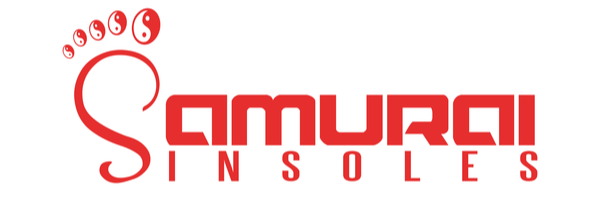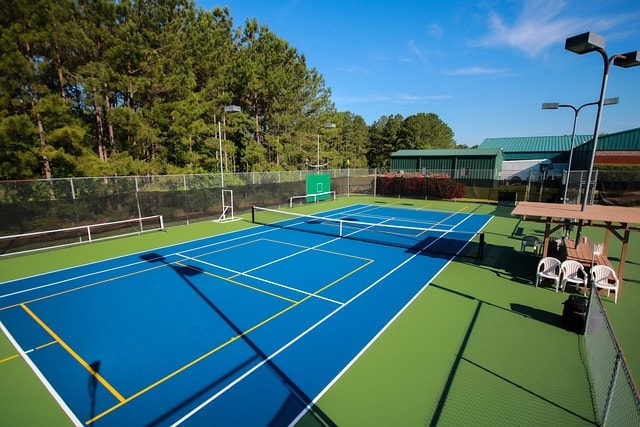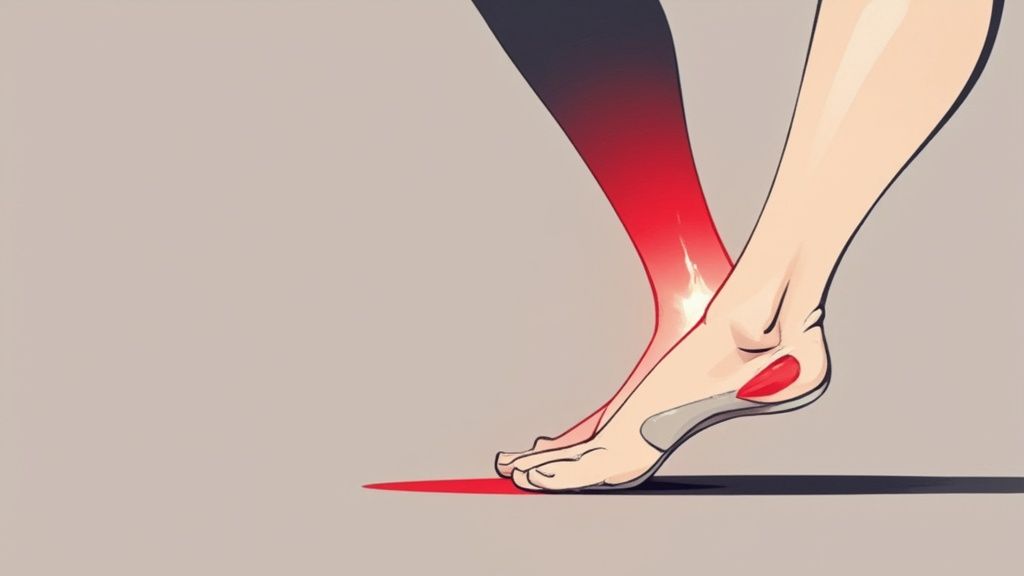If you want to finally get rid of plantar fasciitis for good, it all comes down to a consistent daily routine. I've found that a three-pronged attack works best: targeted stretching, strategic rest, and the right kind of foot support. This approach gets to the root of the problem—the inflammation—and gives that poor, overworked plantar fascia ligament a real chance to heal.
Your First Steps to Immediate Heel Pain Relief
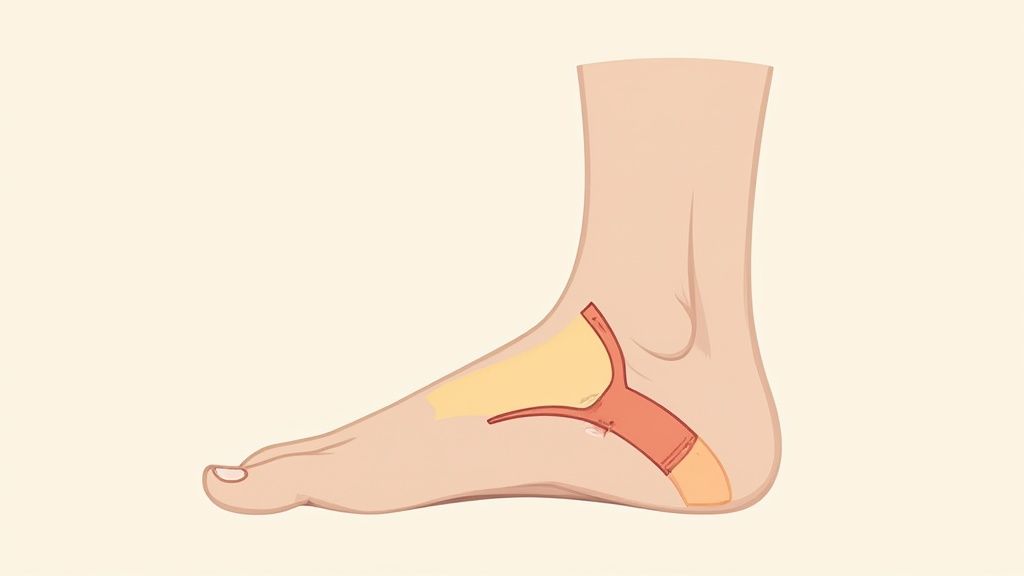
I know that feeling all too well. That first step out of bed feels less like walking and more like stepping on a shard of glass. It’s a brutal way to start the day. But you don't have to just grit your teeth and bear it. Taking immediate, decisive action is the best thing you can do to fight back.
And if you're going through this, you're in good company. Plantar fasciitis impacts about 10% of people at some point, and in the U.S. alone, roughly 2 million people seek treatment for it every year. It’s a widespread and genuinely disruptive problem.
Right now, the goal is simple: calm everything down. Your plantar fascia is like a rubber band that’s been stretched one too many times—it's frayed, angry, and inflamed. The first thing we need to do is stop yanking on it.
Taming Inflammation with the RICE Method
There's a reason doctors have recommended the RICE method for decades. Rest, Ice, Compression, and Elevation is a time-tested strategy for tackling the immediate swelling and pain that's making you miserable.
- Rest: This one sounds easy, but it's often the hardest part. Rest doesn't mean you're chained to the couch. It just means being smart about your activity. For now, pause the long runs on pavement or scale back on shifts where you're standing for hours on concrete.
- Ice: This is your best friend for quick relief. The easiest way I’ve found to do this is to roll a frozen water bottle under your foot for 15-20 minutes at a time. The cold numbs the pain and reduces inflammation, while the bottle's shape gives you a gentle massage.
- Compression: A simple compression sock or an ACE bandage can make a huge difference, especially toward the end of the day. It helps control swelling by preventing fluid from pooling in your foot.
- Elevation: Whenever you get a chance to sit down, prop that foot up. Getting your foot higher than your heart uses gravity to your advantage, helping drain excess fluid away from the injury site.
Key Takeaway: Think of RICE as your first-aid kit. It's not just a passive thing you do; it’s an active strategy to create the perfect healing environment for your foot. By knocking down that initial inflammation, you give your body a head start on the repair process.
When you're hurting, the first instinct is to take action. The table below outlines the most critical first steps to get you on the path to relief quickly.
Immediate Action Plan for Plantar Fasciitis Relief
| Action | Why It Works | How Often |
|---|---|---|
| Ice/Cold Therapy | Directly reduces inflammation and numbs sharp pain signals. | 2-3 times a day for 15-20 minutes, especially after activity. |
| Gentle Morning Stretch | "Wakes up" the fascia before you stand on it, reducing that intense first-step pain. | Before getting out of bed, hold for 30 seconds, repeat 3 times. |
| Activity Modification | Gives the inflamed ligament a break from constant strain, which is essential for healing to begin. | Daily. Avoid high-impact activities until the initial pain subsides. |
| Wear Supportive Shoes | Prevents the arch from collapsing with each step, reducing the pull on the plantar fascia. | Always, especially inside the house on hard floors. |
Following these simple actions consistently will provide the immediate relief you need to start a more comprehensive recovery plan.
Gentle Stretches for Immediate Tension Relief
Now, it’s important not to get overzealous with stretching when your foot is acutely inflamed. Aggressive stretching can actually make things worse. Instead, we want to focus on gentle movements that release some of that tightness in the plantar fascia and the Achilles tendon without causing more irritation.
One of the best things you can do is a simple stretch before your feet even hit the floor in the morning. While still in bed, gently pull your toes toward your shin, hold for about 30 seconds, and repeat a few times. This preps the fascia for that first bit of weight-bearing and can dramatically lessen the shock of that first step.
Interestingly, many of these core principles—rest, ice, and proper support—are the same ones you'd use if you were learning how to heal shin splints fast. It goes to show how fundamental these steps are for treating common lower leg and foot injuries.
These initial actions are your foundation. They won't be an overnight cure, but they provide the relief you desperately need to move forward with a real healing plan. By taking these small but powerful steps right away, you're taking back control and setting yourself up for long-term success.
Mastering Key Stretches for Lasting Relief
While things like ice and rest are great for putting out the immediate fire, a consistent stretching routine is your long-term strategy for winning this battle. Think of your calf muscles and your plantar fascia as a single, connected system. When your calves get tight—and for most of us, they are—they pull on your Achilles tendon. That tension then yanks on your heel bone, putting a ton of strain right where the plantar fascia connects.
This is a huge reason why those first steps out of bed in the morning feel like walking on glass. Overnight, that tissue has shortened and tightened. When you suddenly put your full body weight on it, you get a sharp, painful shock. A good stretching routine breaks this vicious cycle by restoring flexibility and easing that constant, painful pull.
The good news? Conservative treatments for plantar fasciitis are incredibly effective, working for about 90% of people. The research consistently points to targeted stretching for the plantar fascia and Achilles tendon as a cornerstone of successful recovery, helping to heal the tiny tears in the ligament. It's also worth noting that a higher body mass index (BMI) is a major risk factor, so thinking about weight management can be a game-changer for lasting relief. You can dig deeper into the evidence-based methods for plantar fasciitis treatment on Physio-pedia.
This isn't just about going through the motions. Proper form and doing it every single day are what will truly help you get rid of plantar fasciitis for good.
The Essential Towel Stretch for Direct Relief
This is one of the most direct and powerful stretches you can do for the plantar fascia itself. It’s simple, you don’t need any fancy equipment, and you can even do it before your feet hit the floor.
Sit on the floor or the edge of your bed with your painful leg stretched out in front of you. Grab a towel, a belt, or even a dog leash and loop it around the ball of your foot.
Keeping your knee straight, gently pull the towel toward your body. You're looking for a solid stretch along the bottom of your foot and maybe up into your calf. Hold it for 30 seconds. It should feel like a good, productive pull, not a sharp, stabbing pain. Let go, relax for a moment, and repeat this 3-5 times per foot.
Pro Tip: To really zero in on the fascia, use your hand to gently pull your big toe back towards your shin while you do the towel stretch. This simple modification isolates the plantar fascia and gives you a much more targeted stretch right where you need it.
Making this a pre-bedtime ritual can completely change how your mornings feel. You're essentially "waking up" the fascia, making it more flexible and far less likely to scream at you with that first step.
Wall Stretches for Your Calves
Since tight calves are a primary culprit, stretching them is non-negotiable. Your calf is actually two muscles—the big gastrocnemius (upper calf) and the deeper soleus (lower calf). You have to stretch both.
Here’s how to hit each one properly:
- Gastrocnemius Stretch (Straight Leg): Find a wall and place your hands on it for balance. Step one foot back, keeping that back leg perfectly straight with your heel glued to the floor. Lean forward until you feel the stretch in your upper calf. Hold for 30 seconds.
- Soleus Stretch (Bent Knee): Now, from that same starting position, bring your back foot in a bit closer to the wall. This time, bend both knees while keeping your back heel flat on the floor. You should feel this stretch much lower down, closer to your ankle and Achilles tendon. Hold that for 30 seconds.
Switch legs and run through both stretches 2-3 times on each side. Doing these a few times a day, especially after you've been sitting for a while or before you exercise, can make a world of difference. For more helpful techniques, check out our complete guide on how to fix plantar fasciitis.
Simple Foot Flexes You Can Do Anywhere
You don't always need a wall or a towel to keep things loose. You can work on your foot's mobility all day long, even when you're stuck at your desk or binge-watching a show.
Ankle circles are a fantastic start. Just lift your foot off the floor and slowly rotate your ankle in a big circle, 10 times one way, then 10 times the other. This simple movement gets blood flowing and improves the joint's range of motion, which is critical for healing.
Another great one for the office is a simple point-and-flex. Pull your toes up toward your shin, hold for a few seconds, then point them down and away from you, holding again. Repeating this keeps all those small muscles and tissues in your lower leg and foot from getting stiff and angry during long bouts of sitting.
By weaving these key stretches into your daily life, you're not just putting a band-aid on the pain. You are fixing one of the root causes of the problem, building a flexible foundation that will protect your feet and finally bring you lasting relief.
Building Stronger Feet to Prevent Future Pain
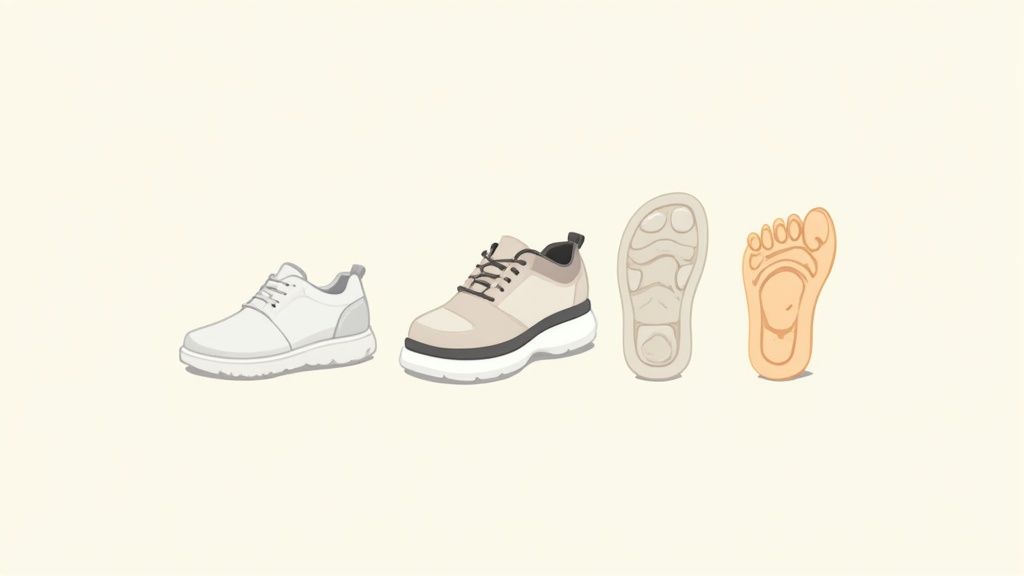
Stretching provides fantastic, immediate relief from that tight, pulling sensation, but it’s only half the battle. If you truly want to get rid of plantar fasciitis for good and keep it from coming back, you need to build a stronger foundation. This means strengthening the small, often-neglected intrinsic muscles inside your feet.
Think of your plantar fascia as a support cable for your arch. When the small muscles that are supposed to help hold up that arch get lazy or weak, the fascia takes on a much heavier load than it was ever designed for. Over time, this constant strain leads to the inflammation and sharp pain you know all too well.
By strengthening these muscles, you create a natural, internal support system for your feet. It’s like building your own custom-fit orthotics right into your anatomy, making your feet far more resilient to the stresses of daily life.
The Foundation of Foot Strength
The goal here isn't about building massive muscles. It’s about waking up and activating the small stabilizers that control your arch. Two classic exercises are perfect for this: towel curls and marble pickups. They might seem simple, but they are incredibly effective at targeting these tiny, crucial muscles.
For towel curls, sit in a chair with your bare feet on the floor and a small towel spread out in front of you. Keeping your heel planted, use only your toes to scrunch the towel toward you. Once you get it all bunched up, push it back out. Do this for a minute or two, and you’ll definitely feel those arch muscles working.
Marble pickups are a great next step. Place about 10-15 marbles on the floor next to a small cup. One by one, use your toes to pick up each marble and drop it into the cup. It’s a challenge of dexterity that forces those intrinsic muscles to engage and fire properly.
Mastering the Short Foot Exercise
Of all the exercises, the short foot is perhaps the most important for building functional arch strength. It directly trains the muscles that lift and support your arch, which is exactly what you need to take the strain off your plantar fascia.
Here’s how to do it correctly:
- Sit in a chair with your foot flat on the floor in a neutral position.
- Without curling your toes or lifting your heel, try to shorten your foot by pulling the ball of your foot back toward your heel.
- Imagine you are trying to "dome" or raise your arch as high as you can. You should feel the muscles deep inside your arch contract.
Hold this contraction for 5-10 seconds, then relax. This is a subtle movement, and it takes practice to get the feel for it. Don’t get discouraged if you can’t see much happening at first; the key is feeling that muscle engagement. Aim for 10-15 repetitions on each foot.
Key Takeaway: Strengthening is a proactive strategy. While stretching manages the symptoms of tightness, building strength addresses the root cause of weakness and instability. A strong foot is a stable foot, and a stable foot puts less strain on the plantar fascia.
Progressing Your Foot Strength Routine
Once you feel comfortable with the basic exercises, it's time to make them more challenging. Progression is the key to continually building strength and resilience. A simple plan can help you get started on the path to stronger, more durable feet.
| Exercise | Starting Point (Weeks 1-2) | Intermediate (Weeks 3-4) | Advanced (Week 5+) |
|---|---|---|---|
| Towel Curls | 1 minute of continuous curls. | Add a light weight (like a book) to the end of the towel. | Perform the exercise while standing. |
| Marble Pickups | Pick up 10-15 marbles. | Use smaller or different shaped objects (like dice). | Perform while standing on one leg for balance. |
| Short Foot | 10-15 reps, 5-second hold (seated). | 10-15 reps, 10-second hold (seated). | Perform the exercise while standing. |
Consistency is everything. Aim to perform these exercises at least 3-4 times a week. You are essentially re-educating your feet on how to support themselves. This doesn’t happen overnight, but with persistence, you will build a powerful foundation that protects you from future pain—a critical step in learning how to get rid of plantar fasciitis for the long haul.
Choosing Footwear and Support That Actually Works

Once you've got a handle on the stretches and strength work, we need to talk about the ground you walk on—or more specifically, what you put between your feet and the ground. Your shoes can either be your greatest ally in this fight or your worst enemy, actively undoing all the hard work you've put in. It's a choice you make every morning.
Think about it. Each step sends a shockwave through your foot. A good, supportive shoe acts like a protective frame, guiding your foot through a healthy motion and absorbing that impact. On the flip side, flimsy, unsupportive shoes let your arch collapse and your foot roll inward (overpronate), which yanks on your already-inflamed plantar fascia with every single step.
And I'm not just talking about your running shoes. This applies to everything—your work shoes, your weekend errand-runners, and even the slippers you wear on your hardwood floors. Consistent support is the key to creating an environment where your fascia can finally heal.
What Really Makes a Shoe Supportive
When you're shopping for shoes to relieve plantar fasciitis, it’s so easy to get distracted by marketing fluff like "cloud-like comfort" or "extra cushioning." While those things are nice, they aren't what actually fixes the problem. You have to become a savvy shopper and look for specific structural elements that create real stability.
Here are the non-negotiables I tell all my clients:
- A Firm Heel Counter: This is the cup at the back of the shoe. Squeeze it. If it squishes down easily, it's useless. You need it to be rigid to stop your heel from wobbling and rolling inward.
- Good Torsional Stability: Try this little test. Grab the shoe by the heel and toe and try to wring it out like a wet towel. A truly supportive shoe will resist this twisting motion. If it twists easily, it has no midfoot stability.
- The Right Flex Point: The shoe should only bend where your foot bends—right at the ball of the foot. If it folds in the middle of the arch, it’s not supporting you; it's just collapsing with your foot.
Finding a shoe that checks these three boxes is a huge leap forward in your recovery. It's a proactive way to offload that constant stress from your plantar fascia.
Many people are surprised by just how much this condition costs them, both in time and money. In the United States alone, the total cost for treating plantar fasciitis is estimated at $284 million annually. It gets personal, too. A staggering 93% of sufferers have monthly out-of-pocket costs, and nearly 28% spend over $250 per month just on pain management. This really highlights the need for solutions that work and last. You can read more about the economic impact and find other plantar fasciitis statistics on KURU Footwear's blog.
The Critical Role of Targeted Support
Here's a secret: even the best shoes often come with flimsy, useless factory inserts. This is where targeted support, like a high-quality insole, becomes an absolute game-changer. Think of it as upgrading your car’s basic suspension to a high-performance system—the frame is solid, but the upgrade makes the ride incredibly smooth and safe.
Insoles designed specifically for plantar fasciitis do way more than add a layer of foam. They are engineered to correct the very biomechanical flaws that are causing your pain.
Take Samurai Insoles, for instance. They are designed with a springy, biomechanically-engineered core that directly combats overpronation. By stopping your arch from collapsing, they instantly reduce the tension on your plantar fascia. This isn't just about feeling comfortable; it's about providing the structural support your foot is missing, giving that inflamed tissue the break it desperately needs to heal.
Choosing the Right Tools for the Job
Your supportive shoe is the foundation, and a specialized insole is the precision tool that perfects the system. It's an incredibly powerful combination for both immediate relief and long-term healing.
To make it simple, I've put together a quick checklist for you. When you're looking at shoes, this is what you need to consider.
Footwear Checklist for Plantar Fasciitis
| Feature | What to Look For (The Good) | What to Avoid (The Bad) |
|---|---|---|
| Heel Support | A firm, rigid heel counter that prevents your heel from wobbling or rolling. | A soft, collapsible heel that offers zero stability. |
| Arch Support | A structured, supportive arch that matches your foot's contour and prevents collapse. | Flat, flimsy insoles that provide no structural support. |
| Flexibility | Bends only at the ball of the foot, where your toes naturally flex. | Bends in the middle of the arch or is completely rigid. |
| Cushioning | Moderate, responsive cushioning that absorbs shock without feeling mushy. | Worn-out, compressed cushioning or overly soft "memory foam" that lacks support. |
Listen, this isn't about tossing every shoe you own and breaking the bank. It's about being intentional. Start with the one pair you wear the most—your daily work shoes or sneakers. Make sure they meet these criteria, and seriously consider adding an orthotic insole like Samurai Insoles to provide that essential, targeted support.
By making smart footwear choices, you take an active role in your recovery every single day. You stop just managing pain and start addressing one of the root causes, creating the perfect conditions for your body to heal for good.
Making Smart Changes for Lasting Foot Health
Getting rid of plantar fasciitis for good means looking beyond just stretches or a new pair of insoles. The real secret to long-term relief is weaving foot-conscious habits into your everyday life. It’s about making smart, sustainable choices that stop you from constantly re-injuring that sensitive tissue in your arch.
Think of it less as a "treatment" and more as building a foot-friendly lifestyle. You'd be surprised how small, consistent tweaks can add up to huge, lasting results.
Modify Your Activities, Not Your Life
Getting a plantar fasciitis diagnosis doesn't sentence you to the couch. Far from it. It just means you need to be a bit smarter about how you move. High-impact activities, like running on pavement or playing sports on a hard court, can hammer your feet. It's like constantly picking at a scab that's trying to heal.
For a little while, try swapping one or two of your high-impact workouts for something gentler that still gets your heart pumping.
- Swimming or Water Aerobics: The water is your friend here. It supports your body weight, giving your feet a well-deserved vacation while you get a fantastic workout.
- Cycling: Whether you're on a stationary bike or cruising outside, cycling is incredibly low-impact on your heels and arches.
- Rowing: This is a killer full-body workout, and you don't even have to be on your feet.
This isn't about giving up the activities you love forever. It's a strategic pause—a way to give your feet the break they desperately need to heal, so you can get back to what you enjoy, but stronger and without that nagging pain.
It's crucial to remember that recovery isn't a straight line. You'll have good days and bad days, and that's completely normal. Understanding the typical timeline can help you set realistic expectations and stick with the plan. For a deeper dive, check out our guide on how long plantar fasciitis typically lasts.
How Your Body Weight Affects Your Feet
This can be a tough subject to talk about, but it’s one of the biggest game-changers for plantar fasciitis. Your feet are your foundation, and every extra pound you carry multiplies the force they have to absorb with every single step.
The science is clear on this one: there's a direct link between a higher body mass index (BMI) and the risk of developing this painful condition. For every pound you lose, you relieve several pounds of pressure from your feet. Even a modest weight loss of just 5-10% can make a massive difference, dialing down the daily strain and inflammation, and making all your other recovery efforts that much more effective.
A Simple Self-Massage for Daily Relief
After a long day, a little self-care can do wonders for foot soreness and help prevent that dreaded morning tightness. One of the best and easiest techniques I know requires nothing more than a frozen water bottle.
Just sit down in a comfortable chair and gently roll the frozen bottle back and forth under the arch of your foot for about 10-15 minutes. This little trick is brilliant because it does two jobs at once: the cold helps calm inflammation, while the rolling motion massages and loosens up the tight fascia.
Making these simple adjustments a part of your daily routine is how you finally stop chasing the pain and start building a lifestyle that supports strong, healthy, and pain-free feet for years to come.
Your Plantar Fasciitis Questions, Answered
When you're dealing with that nagging, sharp heel pain day in and day out, you're bound to have questions. It's easy to get lost in conflicting advice, but getting clear, honest answers is the first step toward getting back on your feet for good. Let's tackle some of the most common questions I hear from people struggling with plantar fasciitis.
How Long Does It Take for Plantar Fasciitis to Go Away?
This is the big one, and the honest answer is: it depends. With a dedicated daily routine, most people start to feel real, lasting improvement within 6 to 10 months. That timeline hinges on consistently doing the right things—stretching, strengthening, and always wearing supportive footwear.
Some mild cases might resolve quicker, but if you've been dealing with this for a while, it's going to take patience. The single most important factor is consistency. You can't just do the stretches when you remember; it has to become a non-negotiable part of your day. That's what separates a quick recovery from a frustratingly long one.
Is It Okay to Walk with Plantar Fasciitis?
Yes, but you have to be smart about it. Gentle movement is good for healing, but walking shouldn't feel like you're stepping on a nail. If it does, you're making things worse. The number one rule? Never walk barefoot on hard surfaces. Your tile and hardwood floors are your enemy right now.
Always have supportive shoes on, even inside the house. If a 20-minute walk triggers your pain, cut back to 10 minutes. The goal is to stay active without aggravating the fascia. You have to listen to your body’s signals—it will tell you when you've done too much.
Key Insight: Staying active is possible, but you have to protect your feet while you do it. Think of supportive shoes and insoles as your personal shock absorbers. They stop the arch from collapsing with every step, which immediately reduces that painful pulling on the fascia.
When Should I See a Doctor for My Heel Pain?
It's probably time to see a doctor or podiatrist if your pain is so severe it’s disrupting your life, or if you've been diligently trying these at-home strategies for a few weeks with zero improvement. A professional can make sure it's actually plantar fasciitis and not something else, like a stress fracture or a pinched nerve.
They can also guide you on the next steps if conservative care isn't cutting it. Our guide on how to treat plantar fasciitis with real relief that works has more detail on when it's time to call in a professional.
Can the Wrong Shoes Really Cause This Problem?
Without a doubt. Unsupportive footwear is one of the top culprits behind plantar fasciitis. Those flimsy, completely flat shoes or your old, worn-out sneakers provide zero support for the structure of your foot.
Every time you take a step in bad shoes, your arch flattens out more than it should. This constant overstretching puts immense strain on the plantar fascia ligament, leading to those tiny tears, inflammation, and the pain you know all too well.
Ready to give your feet the support they need to finally heal? The experts at Samurai Insoles have designed biomechanically engineered insoles to stop overpronation and relieve the strain on your plantar fascia. Find your perfect fit and take the first step towards lasting relief today. Learn more at https://samuraiinsoles.com
